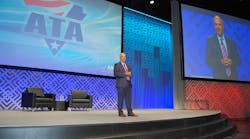LAS VEGAS. While everyone has been waiting for "the big rebound" in the current economic recovery, the U.S. GDP probably won’t grow more than 1.6% this year, according to economist Diane Swonk, founder and CEO of DS Economics “This year could deliver the weakest growth since the Great Recession,” she said speaking at an economic forum during the American Trucking Assns.’ annual conference.
"The economy has been running a relay race, with only one runner - the consumer - carrying the baton for too long,” Swonk said. “Next year, there will be more runners in the race to grab the baton, but they won't be breaking any speed records.”
Joining her on the stage, ATA chief economist Bob Costello said 2016 has been “a simple story” for trucking. “Freight slowed down, we all know that, and we still kept adding capacity.”
Truckload carriers are operating 3% more tractors today than they were in 2014 when available loads outpaced available tractors, according to Costello. That dynamic reversed at the end of 2015 with available tractors outnumber loads.
Large fleets, or those with annual revenues over $30 million, actually dropped capacity by 4.4% year-to-date compared to 2015, but small fleets added 5.5% over the same period, according to Costello. He pointed to lower used truck prices and mileages as one possible factor spurring that tractor growth among the small fleets.
“Also, truckload carriers have added trailer capacity of late, likely in advance of the approaching electronic logging device compliance deadline,” he said. “More small and medium fleets will, I believe, try to compensate for the impact of ELDs by doing more drop and hook to reduce wait times.”
The good news is that load/tractor availability is now showing signs of coming back into balance, according to Costello, who also pointed out that after almost a year of negative growth, “we’ve turned the corner on spot market rates.”
Turning to energy prices, Swonk predicted that recent oil increases into the $40 to $45 per barrel range “are moving us into a sweet spot for both consumers and producers.” Changes in oil production have brought the break even point to around $40/barrel, she said.
That should lead to a pick up in domestic oil production in mid to late 2017, according to Swonk, while consumers will continue to benefit from $40 to $50/barrel oil prices “for the next few years.”
Summing up the session on a positive note, Costello said: “We’re just seeing a little bit of evidence of [lower freight conditions] bottoming out and coming into a modest recovery.”




